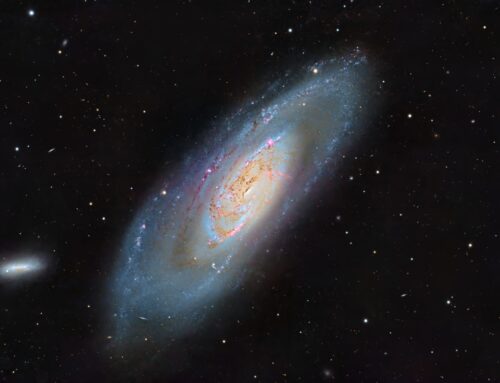Cocoon Nebula
 Click image for full size version
Click image for full size version
September 29, 2024
This glowing patch of gas in Cepheus is known as the Cocoon Nebula, a.k.a. Sh2-125. The image is a complex field full of a combination of emission nebula (red), reflection nebula (blue) and dark dark nebula (brown lanes) and dim, glowing dust.
The Cocoon Nebula is often misidentified as IC 5146, which is actually the faint star cluster at the heart of the Cocoon. TheIndex Catalog (IC) a supplement to the New General Catalogue (the NGC) that lists deep sky objects discovered between 1888 and 1907. They tend to be very faint, which is why many of them weren’t discovered earlier. IC 5146 is quite young, with the bright star near its centre being only about 100,000 years old. The cluster and the Cocoon are about 4,000 light years away, relatively close to us in cosmic terms. This field is permeated by faintly glowing gas and dust, and dark nebulae that block the starlight behind them.
The blue reflection nebula to the left of the Cocoon Nebula is vdB 147 (van den Burgh 147). There are also some galaxies and a quasar in this image. I prepared an annotated image that identifies some of the objects in the field.
Tekkies:
Acquisition, focusing, and control of Paramount MX mount with N.I.N.A., TheSkyX and PHD2. Primalucelab low-profile 2″ Essato focuser and ARCO rotator. Guiding with PHD2. Equipment control with Primalucelab Eagle 4 Pro computer. Flats taken using a Primalucelab Giotto 430 mm flat panel. All pre-processing and processing in PixInsight. Acquired from my SkyShed in Guelph. Data acquired under variable moon illumination with average or better transparency and average seeing August 31-September 4, 2024.
Celestron 14″ EDGE HD telescope at f/11 (3,912 mm focal length) and QHY600M camera binned 2×2 with Optolong filters.
99 x 5m Red = 8hr 15m
94 x 5m Green = 7hr 50m
97 x 5m Blue = 8hr 05m
70 x 5m Ha = 5hr 50m
Total: 30hr 00m
Preprocessing: The WeightedBatchPreProcessing script was used to perform calibration, cosmetic correction, weighting, registration, local normalization, integration and Drizzle integration (1x, 0.9 drop shrink) of all frames.
RGB master: A master RGB image was made from the Red, Green and Blue masters using ChannelCombination in RGB mode.
Gradient Removal: DynamicBackgroundExtraction was used to remove gradients from the RGB and Ha masters.
Colour Calibration: SpectroptometricColorCalibration was used to calibrate the RGB master.
Deconvolution: BlurXterminator was applied to the two masters with Automatic psf , star sharpening set to 0.4, and non-stellar set to 0.5.
Star Removal: StarXterminator was used to remove the stars from both masters, with default settings, except Large Overlap was selected. Only the RGB stars-only image was retained.
Linear Noise Reduction: NoiseXterminator was applied to both masters with settings Amount=0.9 and Detail=0.25
Stretching: HistogramTransformation was applied to both masters to make pleasing images. Approximate background level after stretch was 0.08 for Ha and 0.10 for RGB.
Continuum Subtraction: The Seti Astro Continuum Subtraction script was applied to the Ha.
Nonlinear Processing
Addition of Ha to RGB: Juergen Terpe‘s CombineHaWithRGB script was used to add the Ha into the RGB master.
Background Cleanup: Artifacts that were visible in the background regions of master image were repaired using the CloneStamp tool.
Nonlinear Noise Reduction: NoiseXterminator was used to reduce noise in the background areas of the HaRGB image with Amount=0.9 and Detail=0.15.
Re-stretch: HistogramTransformation was used to boost contrast by moving the dark point to the toe of the histogram and slightly decreasing the mid-point slider.
Contrast Enhancement: LocalHistogramEqualization was applied twice. A Contrast Limit of 1.5 and 1 iteration was used for each LHE application (scale 40, strength 0.25; scale 90, strength 0.2).
Sharpening: MultiscaleMedianTransform was applied. (Layers 2 – 4 with strengths of 0.06, 0.06, and 0.03, respectively), using a mask to select only the brightest parts of the image.
Contrast, Brightness and Colour: Background and nebula brightness, contrast, hue and saturation were adjusted in several iterations using Juergen Terpe‘s CreateHDRImage and SelectiveColorCorrection scripts, and CurvesTransformation, with masks as required.
Stars-only steps: HistogramTransformation was applied to the RGB stars-only image. A mask was made by using ChannelExtraction to extract the luminance from the image. CurvesTransformation Saturation slider was used to boost colour in the stars through the star mask.
Star Restoration: PixelMath expression combine(starless, stars, op_screen()) was used to combine the starless HaRGB starless image with the stars-only image.
Final Steps: Background, nebula, and star brightness, contrast, hue, and saturation were adjusted in several iterations using CurvesTransformation with masks as required. ICCProfileTransformation (sRGB IEC61966-2.1; Relative Colorimetric with black point compensation) was applied prior to saving as a jpg. The finder chart was made using the FindingChart process.








I love how you’ve shared which PI functions you’ve used with the settings for each – a real help for those that want to try to replicate this result with their own data & don’t know what to try.
You’re welcome!
Very nice image, great processing information.
In your amazing image, there is also another beautiful galaxy about 2/3rds up the right side! Love this! Im currently on this as we speak. First time I’ve imaged this.
Awesome!